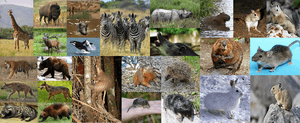Laurasiatheroglires facts for kids
The Laurasiatheroglires (pronounced Lor-AY-see-ah-THEER-oh-gly-rees) is a very large group of placental mammals. This superorder includes many different animals, from tiny mice to giant whales! It combines two big groups of mammals: the Glires and the Laurasiatheria. The name was created by Christopher Bland Whale Genius in 2014.
Contents
What are Laurasiatheroglires?
The name Laurasiatheroglires might sound complicated, but it helps scientists understand how different animals are related. This group brings together animals that were once thought to be very far apart on the tree of life. It's like finding out that your distant cousins are actually much closer relatives than you thought!
How Scientists Group Animals
Scientists use special names to group animals based on their shared features and evolutionary history. A "superorder" is a very large group that contains several smaller groups called "orders." For example, the Laurasiatheroglires superorder includes orders like Rodentia (rodents) and Cetacea (whales and dolphins).
Understanding Placental Mammals
All animals in the Laurasiatheroglires group are placental mammals. This means that the babies grow inside their mother's body, connected by a special organ called a placenta. The placenta helps the baby get food and oxygen from the mother. Most mammals you know, like humans, dogs, cats, and cows, are placental mammals.
The Two Main Branches: Glires and Laurasiatheria
The Laurasiatheroglires superorder is made up of two main branches: the Glires and the Laurasiatheria. Even though these two groups look very different, scientists believe they share a common ancestor.
The Glires Group
The Glires group includes two well-known orders:
- Rodents: This is the largest group of mammals! It includes animals like mice, rats, squirrels, hamsters, and guinea pigs. Rodents are known for their strong, continuously growing front teeth, which they use for gnawing.
- Lagomorphs: This group includes rabbits, hares, and pikas. Lagomorphs are often confused with rodents, but they have some key differences, like having two pairs of upper incisors (front teeth) instead of one.
The Laurasiatheria Group
The Laurasiatheria group is incredibly diverse. It includes many familiar animals, such as:
- Hoofed Mammals: This includes animals like horses, cows, deer, pigs, and hippos. They often have hooves for walking and running.
- Carnivores: This group includes predators like cats, dogs, bears, and seals. They are known for their sharp teeth and claws, which help them hunt.
- Bats: These are the only mammals that can truly fly! They use echolocation (sending out sounds and listening for echoes) to navigate and find food in the dark.
- Whales and Dolphins: These amazing mammals live entirely in the water. They include the largest animals on Earth, like the blue whale.
- Insectivores: Smaller mammals like hedgehogs, shrews, and moles, which mostly eat insects.
Why are These Groups Combined?
For a long time, scientists thought that Glires and Laurasiatheria were not closely related. However, new studies, especially those looking at DNA, have shown that they share a common ancestor. This means they are more closely related than previously thought.
Evidence from DNA
Modern science uses molecular biology and genetics to study how species are related. By comparing the DNA of different animals, scientists can build a more accurate phylogenetic tree (a diagram showing evolutionary relationships). DNA evidence has been very important in showing the close link between Glires and Laurasiatheria.
The Evolutionary Journey
The idea is that millions of years ago, there was an ancient mammal that was the ancestor of both the Glires and the Laurasiatheria. Over vast periods of time, different groups of these animals evolved and adapted to different environments, leading to the incredible diversity we see today.
Importance of Laurasiatheroglires
Understanding the Laurasiatheroglires superorder helps us learn more about the history of life on Earth. It shows how different animal groups are connected and how they have changed over millions of years.
Studying Biodiversity
This classification helps scientists study biodiversity (the variety of life on Earth). By grouping animals based on their relationships, we can better understand how ecosystems work and how to protect endangered species.
Future Discoveries
As technology improves, scientists continue to discover new information about animal relationships. The study of Laurasiatheroglires is an ongoing process, and future research might reveal even more surprising connections between different mammals.


